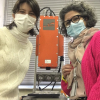The EU-funded TISCH project has demonstrated that terahertz imaging and spectroscopy can be a viable, non-destructive and non-invasive tool to aid the retrieval and analysis of images of obscured features of artwork. Through a Marie Curie Postdoctoral Research Fellowship, Dr Bianca Jackson from the University of Reading in the UK was able to apply this technique to inspect layers of paint, detect structural defects in ceramics and image the physical structure of paintings and manuscripts.
“Institutions that carry out cultural heritage research don’t have a lot of extra money for emerging technology, but they do have the hearts and minds of the people—folks love to talk about what is being done with technology to better understand the mysterious Mona Lisa, or whether or not a sarcophagus contains Queen Neferititi”, says Jackson. “So one of best ways to reduce costs and increase the accessibility of terahertz technology to open up new and interesting areas of applied research.”
In the last 15 years there has been exponential growth in terahertz technology and applied research, along with increasing interest from the pharmaceutical, biomedical, security and aerospace industries. “In the US, 9/11 and the Columbia disaster lead to a large influx of research funding, which has helped to drive this growth”, explains Jackson.
However, the cost of terahertz systems is still much higher than other well-established technologies, which is why further applied research is needed. Furthermore, terahertz spectroscopic imaging has only been used in the field of cultural heritage over the last five years or so, and as a result, its utility to conservation has not been extensively demonstrated. In order to address this, Jackson examined the walls of several European churches in England, France and Latvia, where centuries-old paintings were hidden behind many layers of plaster and plain paint. “We use a time-domain terahertz system, which has a pulse that allowed us to separate out the signals from the top and sub-surface layers”, she explains. “This enabled us to find some designs behind some perfectly plain white walls.”
Jackson also scanned a Palaeolithic wall etching of a bird obscured by flow rock and investigated heritage conservation-friendly materials that can be safely applied to works in order to improve the signal to noise quality of the terahertz image. “Most recently, we started working with the Tate Museum to use terahertz imaging to diagnose flawed areas of ceramic glaze on outdoor sculptures left out in the rain”, she adds. “While the TISCH project is almost finished, I’m very excited about the implications of our work with the Tate.”
Jackson is confident that the TISCH project represents a positive step forward, with similar cultural heritage projects also now coming on line. “Horizon 2020 is funding a project called IPERION CH, through which there is a great programme called MOLAB (short for mobile laboratory) that is accepting proposals for research using various advanced diagnostic technologies for cultural heritage,” she says. “Recently, they added terahertz time-domain spectroscopy and imaging as an option. I’ve been encouraging interested conservators to apply for MOLAB access, and I’ve been offering my aid.”










